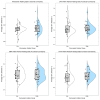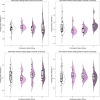Associations of lifetime concussion history and repetitive head impact exposure with resting-state functional connectivity in former collegiate American football players: An NCAA 15-year follow-up study
- PMID: 36084077
- PMCID: PMC9462826
- DOI: 10.1371/journal.pone.0273918
Associations of lifetime concussion history and repetitive head impact exposure with resting-state functional connectivity in former collegiate American football players: An NCAA 15-year follow-up study
Abstract
The objective of this study was to examine associations of lifetime concussion history (CHx) and an advanced metric of lifetime repetitive head impact exposure with resting-state functional connectivity (rsFC) across the whole-brain and among large-scale functional networks (Default Mode; Dorsal Attention; and Frontoparietal Control) in former collegiate football players. Individuals who completed at least one year of varsity collegiate football were eligible to participate in this observational cohort study (n = 48; aged 36-41 years; 79.2% white/Caucasian; 12.5±4.4 years of football played; all men). Individuals were excluded if they reported history/suspicion of psychotic disorder with active symptoms, contraindications to participation in study procedures (e.g., MRI safety concern), or inability to travel. Each participant provided concussion and football playing histories. Self-reported concussion history was analyzed in two different ways based on prior research: dichotomous "High" (≥3 concussions; n = 28) versus "Low" (<3 concussions; n = 20); and four ordinal categories (0-1 concussion [n = 19]; 2-4 concussions [n = 8]; 5-7 concussions [n = 9]; and ≥8 concussions [n = 12]). The Head Impact Exposure Estimate (HIEE) was calculated from football playing history captured via structured interview. Resting-state fMRI and T1-weighted MRI were acquired and preprocessed using established pipelines. Next, rsFC was calculated using the Seitzman et al., (2020) 300-ROI functional atlas. Whole-brain, within-network, and between-network rsFC were calculated using all ROIs and network-specific ROIs, respectively. Effects of CHx and HIEE on rsFC values were examined using separate multivariable linear regression models, with a-priori α set to 0.05. We observed no statistically significant associations between rsFC outcomes and either CHx or HIEE (ps ≥ .12). Neither CHx nor HIEE were associated with neural signatures that have been observed in studies of typical and pathological aging. While CHx and repetitive head impacts have been associated with changes in brain health in older former athletes, our preliminary results suggest that associations with rsFC may not be present in early midlife former football players.
Conflict of interest statement
I have read the journal’s policy and the authors of this manuscript have the following competing interests: BLB reports grants and support from the National Institute of Neurological Disorders and Stroke and National Institute on Aging under the National Institutes of Health. KMG reports compensation from National Collegiate Athletic Association for other services and grants from Boston Children’s Hospital (sub-award from the National Football League). MAM acknowledges researching funding from the National Institutes of Health, U.S. Department of Defense, Centers for Disease Control and Prevention, National Collegiate Association and National Football League (via subaward from Boston Children’s Hospital). No other conflicts of interest are declared for the remaining authors.
Figures





References
-
- Petersen RC, Lopez O, Armstrong MJ, Getchius TSD, Ganguli M, Gloss D, et al.. Practice guideline update summary: Mild cognitive impairment: Report of the Guideline Development, Dissemination, and Implementation Subcommittee of the American Academy of Neurology. Neurology. 2018;90: 126–135. doi: 10.1212/WNL.0000000000004826 - DOI - PMC - PubMed
Publication types
MeSH terms
Grants and funding
LinkOut - more resources
Full Text Sources
Medical

